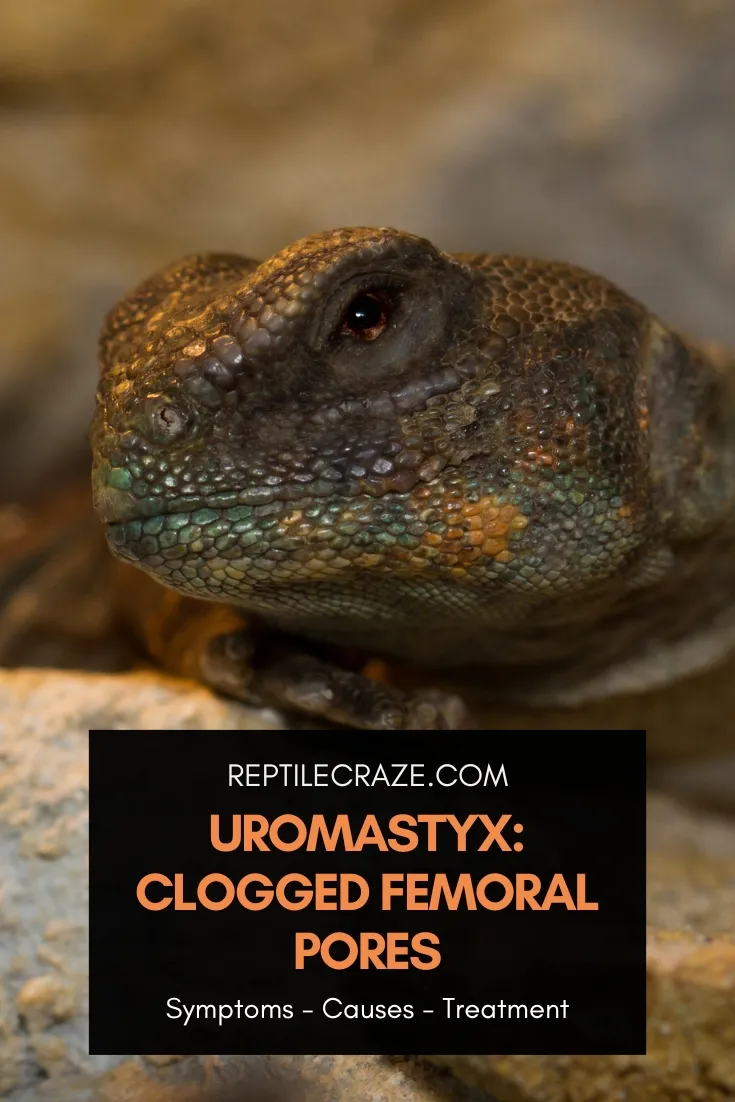
Uromastyx, also known as spiny-tailed lizards or dabb lizards, have unique appearances and behavior, making them incredibly appealing pets. But this type of lizard can suffer from clogged femoral pores, which can worry beginner and veteran hobbyists alike.
One of the most common reasons why Uromastyx get clogged femoral pores is insufficient activity. Femoral pores contain wax-like secretions, which can build up. Moving around and rubbing against various surfaces can dislodge these, but sometimes, pet lizards will fail to do this.
Of course, there are other reasons, as well. In this article, we’ll cover everything you need to know so that you can quickly help your reptilian friend get rid of their clogged femoral pores.
Table of Contents
What Causes Clogged Femoral Pores in Uromastyx?

Not all lizards have femoral pores, but some, like Bearded Dragons and Uromastyx, do.
Femoral pores are secretory glands exhibited by many reptiles, including Uromastyx, and are typically on the underside of their hind legs, just before their anal opening.
They have important functions in lizard communication, such as marking territory, determining the sexes of other lizards, and more.
However, they can accumulate buildup that can result in clogging of the pores and subsequent pain and discomfort.
As mentioned above, the most common reason why a Uromastyx may get clogged femoral pores is insufficient activity.
Wild lizards tend to rub their body on various surfaces, and this is usually enough to dislodge any wax that has accumulated in the pores.
But pet lizards, especially those in an enclosure with limited space, may not move around enough to clear out the wax.
Another common cause of clogged femoral pores is a poor environment. If the enclosure isn’t cleaned regularly, and if shedding isn’t monitored and removed, the wax buildup can get worse and become impacted.
This is especially true if the temperature and humidity levels in the
Tip: If you need more info on how to take care of your uromastyx, read our care guide here!
Spotting Clogged Pores in Uromastyx
Clogged femoral pores can cause problems and pain, especially when they become swollen and infected.
But before we go into the details of how to unclog your pet’s femoral pores, let’s first talk about how to spot clogged pores in your Uromastyx.
Here are the signs you should look out for:
- Discoloration. Look for areas of skin that appear discolored or darker than the surrounding skin. This can be a sign of a clogged pore that is not allowing the skin to shed properly.
- Swelling. If a pore is clogged, it can become swollen and appear larger than normal. This is usually accompanied by redness and inflammation.
- Scale build-up. If the scales around a pore become thick and bumpy, it can be a sign of a clogged pore.
- Discharge. You may also see a waxy substance coming out of their femoral pores. These secretions can vary, with colors ranging from slightly yellowish to brown. They can also have a waxy or harder texture.
- Behavioral changes. If your lizard suddenly changes its behavior, it might be because they are suffering from pain and stress – which could be a reason to check its femoral pores.
Cleaning Clogged Femoral Pores in Uromastyx
Cleaning clogged femoral pores can be pretty straightforward. Just like with bearded dragons, most of the time, you just have to gently soften and rub your uromastyx’s clogged pores clean.
Other times, you may have to pull it out yourself.
If you want to know how to do this at home, here’s a step-by-step guide.
Reminder: if the pore looks inflamed or infected, don’t even attempt to unclog it yourself. Just take your Uromastyx to the vet right away.
- Let your Uromastyx soak in a shallow tub with warm water for 10-15 minutes. This can help soften the waxy substance and make it easier to remove.
- Use a soft, damp cloth to gently wipe away any visible blockages. Some also opt for a toothbrush to do the scrubbing. Be careful not to apply too much pressure, or you could cause your lizard some pain.
- If the blockages are severe, you may need to use a sterilized needle or tweezers to remove them carefully. This should only be done by a veterinarian or an experienced reptile owner, though, as it can be harmful if done incorrectly.
- After the contents of the clogged pore have been expressed, you can treat the area with an antibiotic ointment to prevent infection.
Keep in mind, it’s not good practice to squeeze clogged femoral pores. While it’s not exactly a mortal sin, it’s always possible to squeeze too much or too hard, which can cause pain to your Uromastyx or even lead to an infection.
If you’ve already soaked your Uromastyx in warm water and you still can’t wipe away the blockage, simply take your lizard back to its enclosure and allow it to rub its body on hard surfaces. The pore should eventually clear up.
Maintenance and Prevention
Simply cleaning out your Uromastyx’s pores isn’t enough. Once the blockages have been removed, it’s important to take steps to ensure that the problem doesn’t recur.
Here are some measures you can take to keep your Uromastyx’s pores clear and healthy:
- Maintain a clean enclosure. Regularly clean your lizard’s enclosure to prevent dirt and debris from accumulating, which can cause blockages.
- Regular soaking. Soaking your pet in warm water for 10-15 minutes once or twice a week can help keep the femoral pores clean and prevent buildup.
- Add new decor. Rough surfaces such as hardscapes and branches can help scrape the secretion off the lizard’s body, minimizing the chance of clogged pores.
- Monitor shedding. Make sure to keep up with your lizard’s regular shedding process, as a buildup of shed skin can also clog their pores.
- Enchi Ball Python: A Unique and Stunning Morph of Python regius - March 27, 2025
- Emerald Tree Monitor: The Enigmatic Green Guardian of the Rainforest - March 26, 2025
- The Egyptian Cobra (Naja haje): A Fascinating Serpent - March 25, 2025
